My garden is a bit over an acre and filled with plants of every shape and size, and growing every day. I’ve forgotten the names of many over the years, there being too many hostas and other wonderful odds and ends with too little distinction between for my poor feeble mind.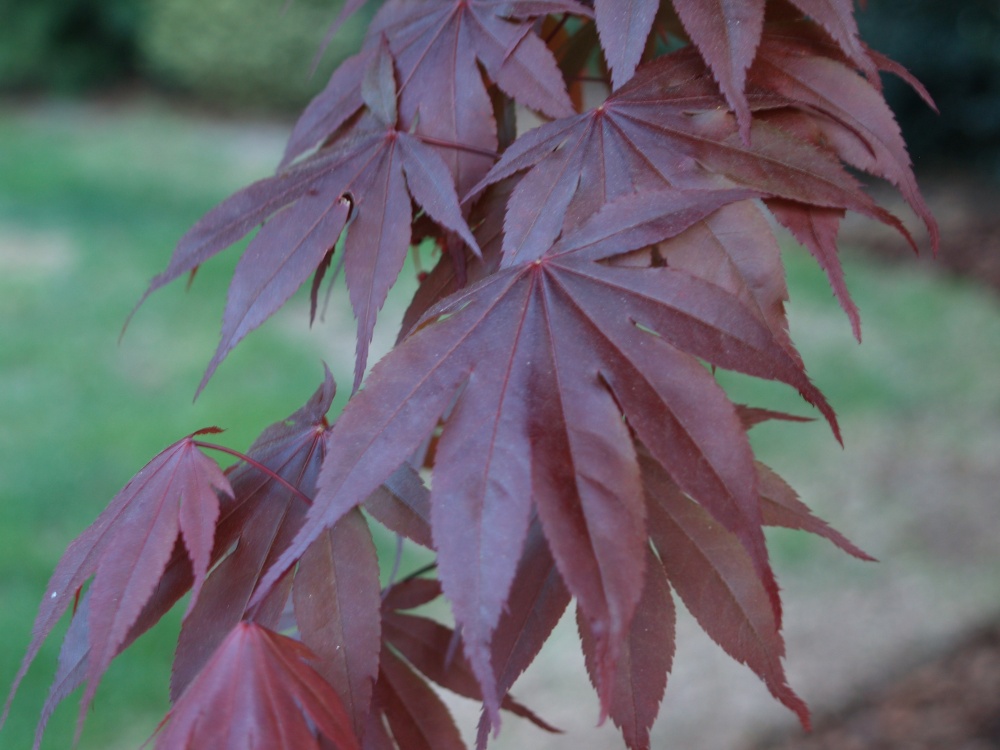
I know little or nothing about their lineage, or who found them on a mountainside wherever. I know plants that grow well, mostly from experience, and ones that have interest that should earn a spot in others’ gardens. Japanese maples deserve a spot in every garden.
All of the following Japanese maple photos were taken in my garden. I’ve no doubt that there are collectors with more, but I have nearly as many as I need. Last year I added two new plants, a Full Moon maple (above), and an odd compact upright ‘Shaina’ (below). I’ve been trying to find a Full Moon of substantial size for a reasonable price (meaning cheap) for years, and found one with a scarred trunk from a grower in Oregon. The scar made the tree unsellable, except to me.
I found a spot that I needed to plug a shrub into, and ‘Shaina’ became that shrub. Although a small tree growing only to five or six feet tall and wide, I’m certain that it will grow much larger than the space I’ve set aside for it, so when that happens I’ll carve a wider area and move its neighbors to give them proper room.
This happens frequently to the gardener, at least it does to me, and choices must be made to determine who stays and who goes. The Japanese maple always stays.
There are many thousands of Japanese maples, and dozens of varieties readily available through nurseries, so how can you possibly pick the right one for your garden?
First, calculate the room available for the maple to grow. Weeping varieties, deemed to be dwarf, will occupy a ten foot by ten foot area much quicker than you think. Many upright varieties will grow nearly thirty feet in height, with a similar spread. Neither is appropriate to be planted in close proximity to a house, walk, or patio.
Gardeners, and even landscape designers, mistakenly plant Japanese maples so that they must be chopped and mangled to keep within bounds and from blocking walkways. Resist the urge to plant before proper consideration, and give ample space for these graceful trees to show their character. Allow seven to eight feet from a walk or patio for weeping varieties, and double this for uprights. If you don’t have adequate space, plant a maple that matures to a smaller size, not just a smaller size of the same tree.
Now that we have considered the space available for our Japanese maple, we can move to aesthetic details, leaf color and shape, Fall color, texture, and branching structure. After deciding small tree or large, weeping or upright, we can scarcely go wrong with any selection, for each has its beauty.
Weeping Japanese Maples ‘Dissectum’ is the description given to maples for their finely divided lacy leaves, and for this and their generally smaller size they are most popular.  Leaves can be green, as with Viridis (left), or red, found in many popular varieties such as Crimson Queen (below), Garnet, Tamukeyama, Red Dragon, and many more. For many people these are indistinguishable, but each has a distinct character in size, coloration, or branching structure.
Leaves can be green, as with Viridis (left), or red, found in many popular varieties such as Crimson Queen (below), Garnet, Tamukeyama, Red Dragon, and many more. For many people these are indistinguishable, but each has a distinct character in size, coloration, or branching structure. 
The branching of Crimson Queen is so full that it is often referred to as a big red mushroom, while Garnet has an open growth habit to ten feet tall and would hardly be considered to have pendulous branches. Though often placed without being allotted adequate space, weeping maples are ideal for most small gardens.
I have only two weeping maples in my garden as I have plenty of room for larger trees, and I prefer the diverse leaf shapes and colors of the upright Japanese maples.
Upright growing Japanese Maples range from slow growing trees such as ‘Butterfly’ to the fast growing ‘Bloodgood’, and strict upright to wide spreading shapes.
 Butterfly Maple (above) has beautiful variegated leaves of green, white, and a bit of pink in the Spring. It is a slow growing, densely branched tree that will reach ten feet in height if I live so long.
Butterfly Maple (above) has beautiful variegated leaves of green, white, and a bit of pink in the Spring. It is a slow growing, densely branched tree that will reach ten feet in height if I live so long.
 Most Japanese maples are Acer palmatum, but several lesser known are Acer japonicum or Acer shirasawanum, including the Fern Leaf maple, ‘Aconitifolium’ (above showing Fall color), and the Golden Full Moon maple ‘Aureum’ (pictured near the top). Fern Leaf maple is a nice, small spreading tree, but really takes a front seat in the garden with its Fall color. The Golden Full Moon prefers a break from the afternoon Summer sun to show its leaf color and not burn the leaves, and is quite slow growing.
Most Japanese maples are Acer palmatum, but several lesser known are Acer japonicum or Acer shirasawanum, including the Fern Leaf maple, ‘Aconitifolium’ (above showing Fall color), and the Golden Full Moon maple ‘Aureum’ (pictured near the top). Fern Leaf maple is a nice, small spreading tree, but really takes a front seat in the garden with its Fall color. The Golden Full Moon prefers a break from the afternoon Summer sun to show its leaf color and not burn the leaves, and is quite slow growing.
‘Bloodgood’ maple is the most common of the red leaved upright Japanese maples (seen at the top of the page) and is a fine tree reaching over twenty-five feet, but there are many others with distinctive leaf color or shape. Some are not popular in commerce because they are more “unusual” than beautiful.
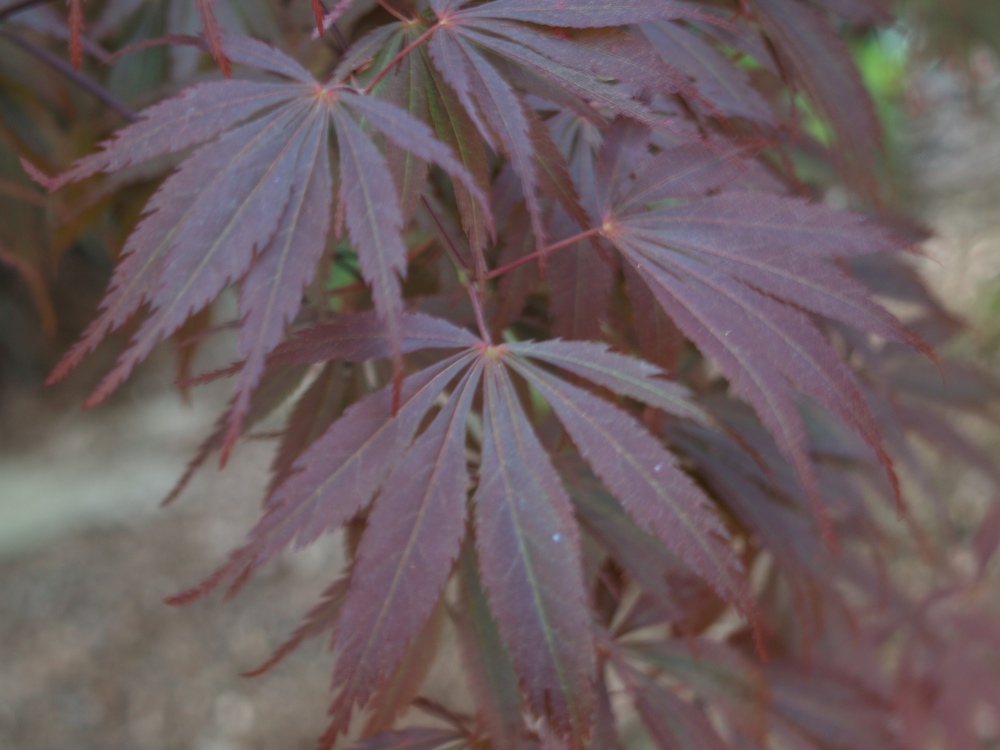 ‘Burgundy Lace’ (above) is similar in growth to ‘Bloodgood’, but spreads slightly more and grows not quite as tall, and leaves are more finely dissected.
‘Burgundy Lace’ (above) is similar in growth to ‘Bloodgood’, but spreads slightly more and grows not quite as tall, and leaves are more finely dissected.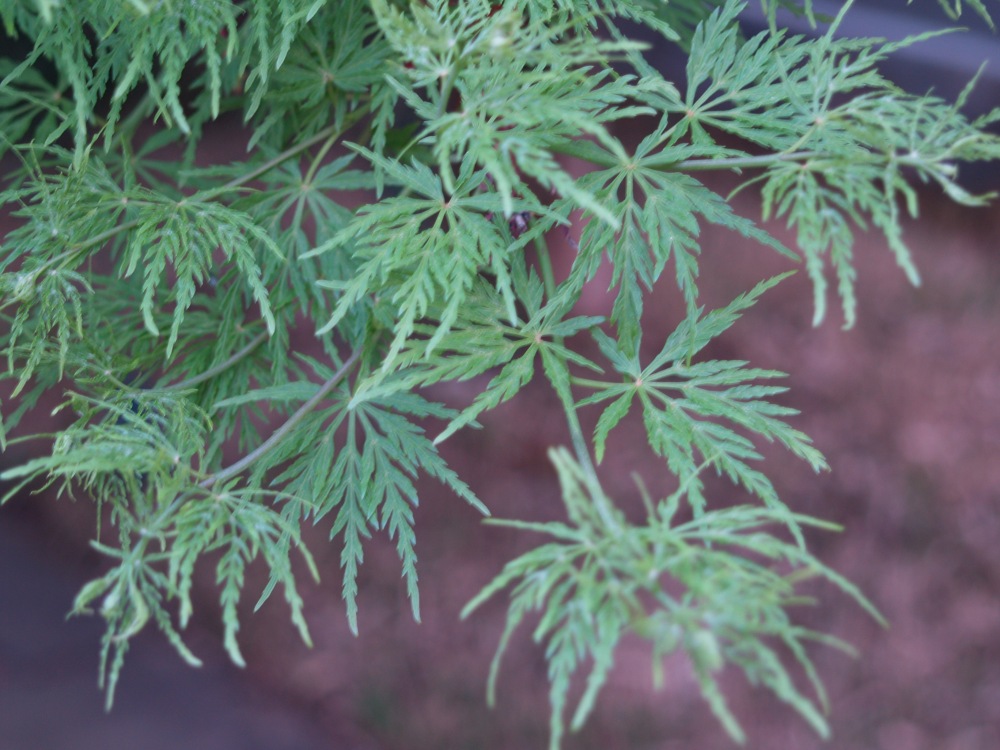
‘Seriyu’ has an upright growth habit to about fifteen feet with green dissectum leaves. The red Fall color is outstanding. I have planted two of these quite close to my house with the intention of walking under them as you follow the path to the front door. For several years the path was impassable until Seriyu grew large enough to prune the lower branches. Now the entry is wonderful.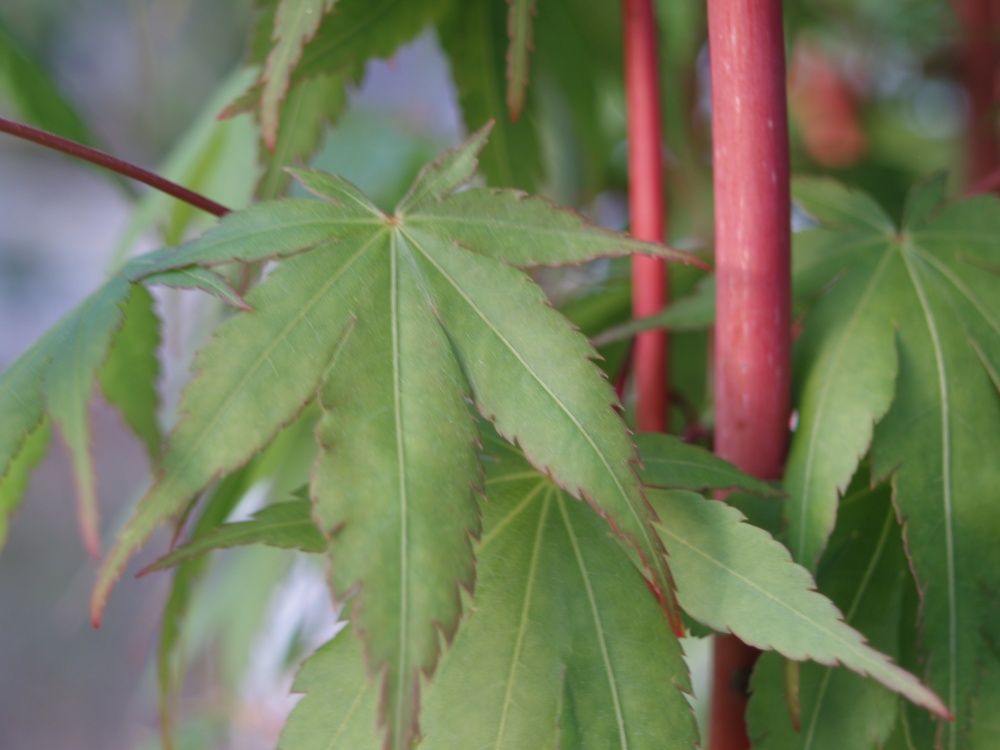
‘Sangu Kaku’ the Coral Bark maple has brilliant red stems that stand out in the Winter, but is rather ordinary with leaves.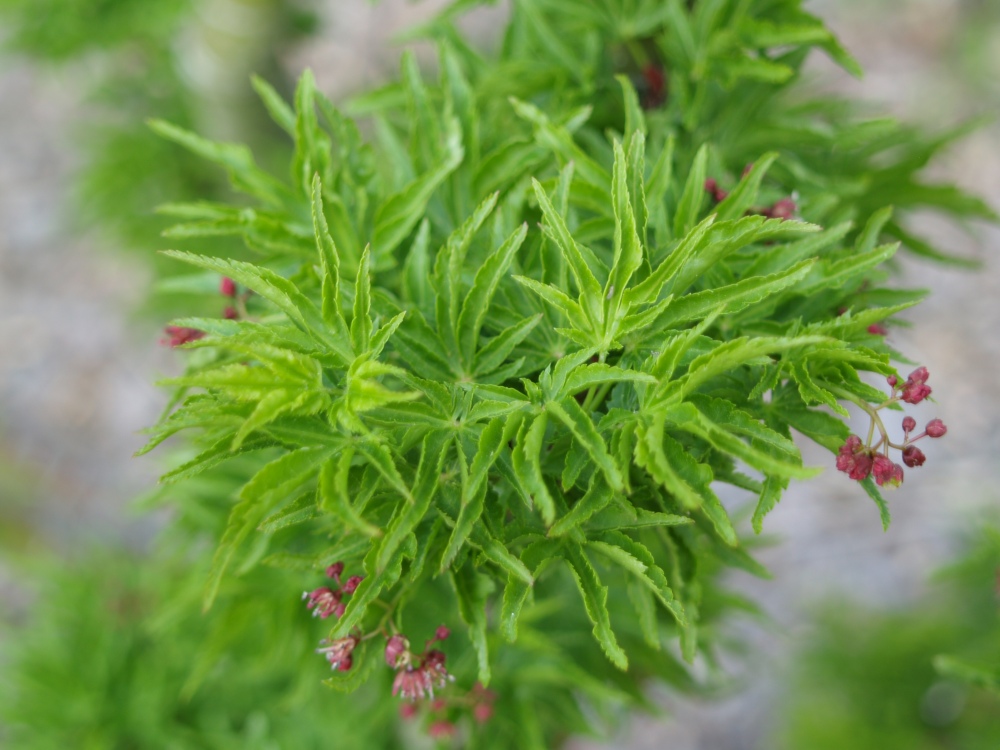
‘Shishigashira’ is quite unusual, called Lion’s Head maple. Crinkled leaves are bunched on branches giving the tree an irregular shape. Fall color is outstanding, and very slow growing, but this is not a tree that everyone will appreciate. I like it enough that I have two.
‘Linearilobum’ or perhaps ‘Atrolinear’ is notable for the spidery red leaves. In my garden a large tree from the forest edge was arching over this tree, and I knew that in another year it would fail from too much shade. The removal was a bit tricky in order not to damage the Japanese maple, but hardly a branch was scratched.
 ‘Okushimo’ has unusual coarse green leaves where each lobe curls inward. It has spectacular Fall color, and a narrow upright shape, but is a bit too odd for most gardens, and it’s green while most people prefer red.
‘Okushimo’ has unusual coarse green leaves where each lobe curls inward. It has spectacular Fall color, and a narrow upright shape, but is a bit too odd for most gardens, and it’s green while most people prefer red.
 ‘Orido Nishiki” is a medium height grower (up to 15-18′) with green leaves splashed with pink and white. I have planted mine on the back side of a tall hornbeam hedge, so it is protected from the hot afternoon sun. Unfortunately, it is underplanted with a bamboo that has decided that it wants to grow taller than it should, so this beautiful maple is not as obvious as it should be.
‘Orido Nishiki” is a medium height grower (up to 15-18′) with green leaves splashed with pink and white. I have planted mine on the back side of a tall hornbeam hedge, so it is protected from the hot afternoon sun. Unfortunately, it is underplanted with a bamboo that has decided that it wants to grow taller than it should, so this beautiful maple is not as obvious as it should be.
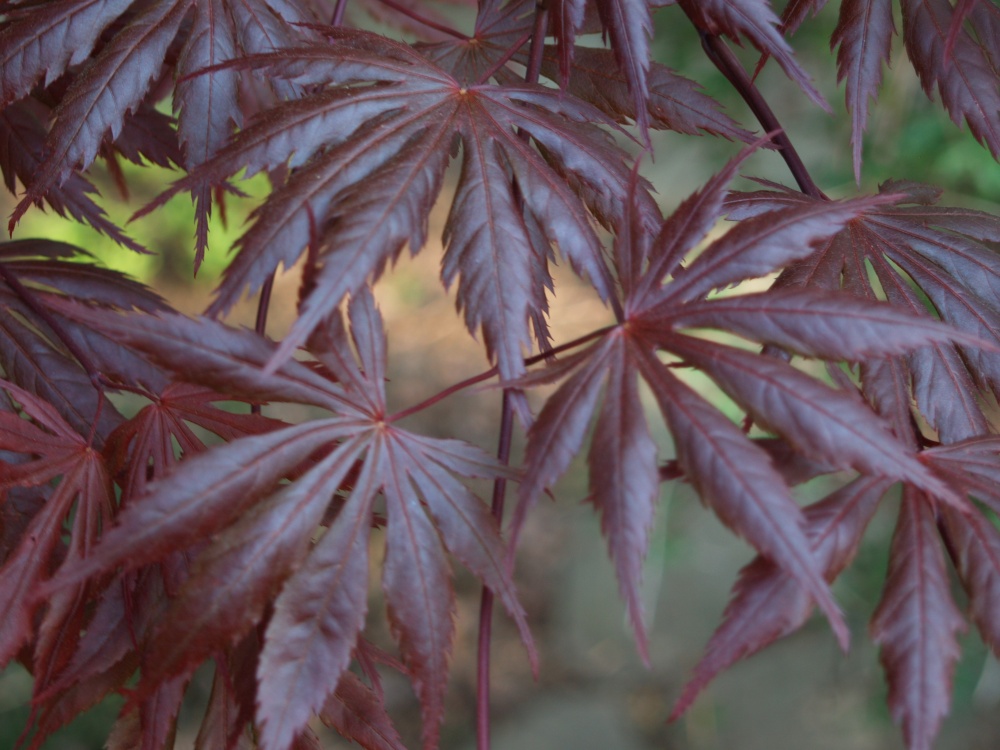 My collection ends with another maple that I should know the name of, but have forgotten. It matters little though, the names are only important in commerce. The Japanese maples were planted for my enjoyment, and there is no tree in my garden that brings more satisfaction.
My collection ends with another maple that I should know the name of, but have forgotten. It matters little though, the names are only important in commerce. The Japanese maples were planted for my enjoyment, and there is no tree in my garden that brings more satisfaction.
What a beautiful collection of so many fantastic maples. Always loved Japanese maples, but have never grown any. Looking through this showcase of the different kinds has the effect of creating lots of motivation to include some somewhere in my garden.
I really appreciate the pictures and descriptions you have provided of the many Japanese maples here.
Outstanding post, Will visit once more:)
Hello,
I have a number of Japanese maples, they are one of my favorite trees. This pass weekend i added 2 new trees to my collection, and checking to find out more about them i came upon your site. This is a very well written site , easy to follow, great photo and information. Well done. My 2 new trees are the Butterfly & the Lionshead Maple.
Regards
Velmon
Both excellent choices. My Butterfly maple is probably ten years old, and only slightly over six feet tall. It started as a four footer with severe Winter injury, so it took a couple years to come back from the bad start.
I have planted large Lionshead maples for Landscape customers, and they are great maples. Thanks for the comments.
Dave
Today I purchased a Fern Leaf Maple about 5 feet tall. How tall should I expect it to grow? Would it do well in a really large clay pot made for a small tree?
Fern Leaf maples will grow to at least fifteen feet in height, and mine is wider than tall. Growing it in a container will slow its growth somewhat, but at some point the roots will be too extensive for the pot.
Also, if you live in an area with temperatures well below freezing in the winter there are concerns with root damage since roots are more susceptible to freeze injury than the above ground parts of the tree.
Hi. I love Japanese maple trees, and I have 2 already. I like to keep them in very large pots, and move them in my garden. I would now like to purchase a Disectum leaf (feather type) in red. I have viewed 2 at the weekend. One is called Palmatum Dissectum Tamukeyama. It was beautiful and expensive! I love the umberella shape. It was approx 4ft tall, and the leaves were bright red. I then saw a 2nd, again beautiful shape, but darker red leaves, and I noticed the underside to these leaves was dark green. We both agreed with prefered the Tamukeyama, but is it right for us? We want to keep it potted, love the umberella shape and the bright red, yet searching internet, Palmatum means upright, not weeping? Am very confused, and there are so many to choose from. Ive tried to search images, and am getting more confused. Can anyone adivse me please? I would very much appreciate thoughts from an experience maple lover!!!
Most Japanese maples are Acer palmatum, though there are some lovely exceptions. Palmatum refers to the leaf shape, palmate referring to a shape similar to the hand. The weeping forms are Acer palmatum dissectum. The palmate foliage shape is finely dissected.
‘Tamukeyama’ is a superior weeping Japanese maple with vigorous growth and foliage color that holds into the summer.
Oh thank you Dave. Could I therefore ask you, will the Tamukeyama do well in a pot? And can I maintain its height easily? For example, 5 – 6 ft would be a maximum height.
Nicky
The unknown maple is called “Trompenbourg”, I am sure of it.
Yes, the maple is Trompenburg. I forget, occasionally.